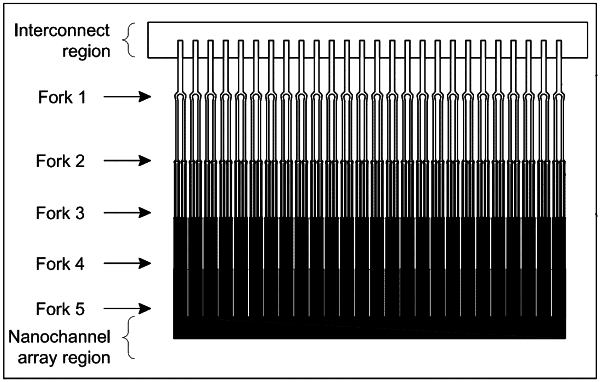| CPC B81C 1/00119 (2013.01) [B01L 3/502761 (2013.01); B01L 2200/0663 (2013.01); B01L 2200/0689 (2013.01); B01L 2200/10 (2013.01); B01L 2300/0816 (2013.01); B01L 2300/0851 (2013.01); B01L 2300/0858 (2013.01); B01L 2300/0864 (2013.01); B01L 2300/0887 (2013.01); B01L 2300/168 (2013.01); B01L 2400/0415 (2013.01); B01L 2400/043 (2013.01); B01L 2400/0442 (2013.01); B01L 2400/0487 (2013.01); B01L 2400/086 (2013.01); B81B 2201/058 (2013.01); B81C 2201/019 (2013.01); G01N 2021/0346 (2013.01); G01N 2021/6439 (2013.01); Y10T 29/4981 (2015.01)] | 20 Claims |

|
1. A method of fabricating an analysis device, comprising:
bonding a first substrate and a second substrate,
the bonding giving rise to an enclosed conduit disposed between the substrates, the enclosed conduit being capable of transporting a fluid therethrough,
wherein the enclosed conduit comprises a first front-end branched channel region and a nanochannel analysis region,
wherein the first front-end branched channel region comprises at least a primary channel characterized as having a cross-sectional dimension of from about 10 nm to about 10,000 nm and at least two secondary channels downstream and divided from the primary channel, wherein the total cross-sectional area of the at least two secondary channels is approximately equal to the cross-sectional area of the primary channel, thus maintaining an approximately constant flow rate wherein the ratio of the cross-sectional dimensions of the primary channel to the at least two secondary channels is in the range of 100 to 10,000, wherein the first front-end branched channel region comprises stacked array of channels having progressively reduced cross sectional dimensions, wherein the channels are connected by one to five levels of forks.
|